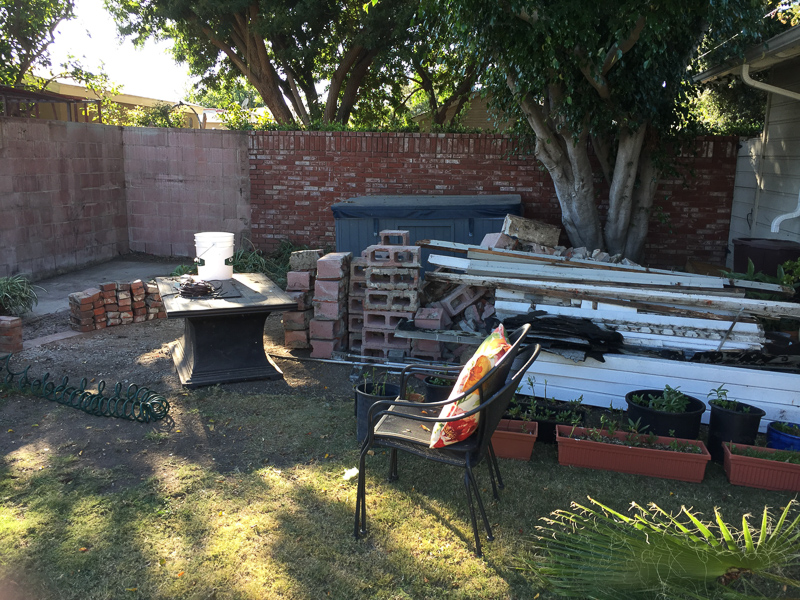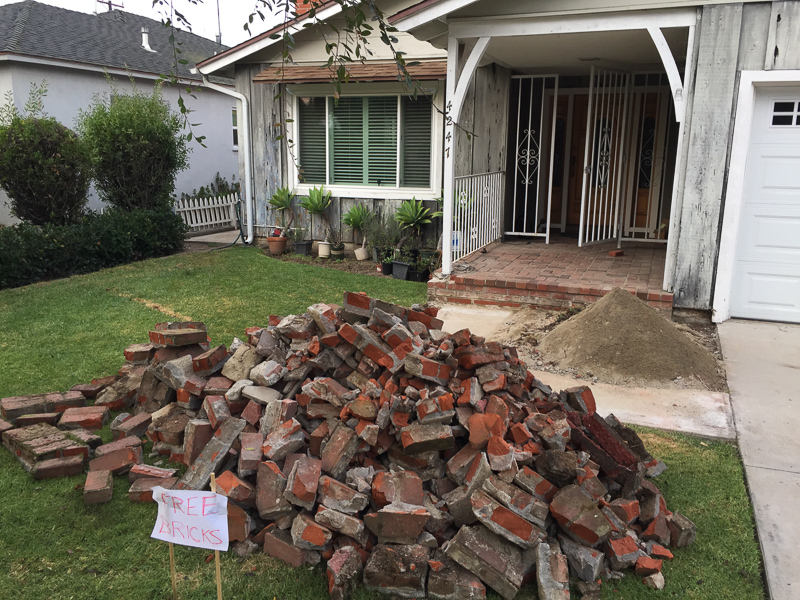Continuing from Part 1, our journey to convert the boring grass landscaping of our home into a wildlife-friendly, low-water environment with more usable space took an eternity for us to figure out how to begin, but the project accelerated greatly in May 2018 when we met with Tom Stout of Stout Design Build, and after getting excited by his initial sketches we hired him in June 2018 to do a full design.
After we struggled to make even the most basic decisions about what our yard should look like, it was humbling to have Tom come over and within five minutes see a drawing start forming that got us excited. Not only did his ideas show a beautiful, functional yard, but he integrated our suggestions while making sure more mundane needs like drainage were being accounted for. At one point during his initial visit I mentioned that I wanted a fountain or some other sort of water feature for the animals, he looked at the drawing he was making, and said the now-fateful words “what about a stream”? Audrey’s eyes opened wider than any human’s eyes should be able to open, and she practically yelled “OH MY GOD I WOULD LOVE A STREAM!”. I was skeptical, but they proceeded at a furious pace to discuss ponds and other features, so it felt like a win when I was finally able to dial things back to “just” a stream. Audrey was practically glowing for the next several months every time she talked about having a stream in the yard, and now that it’s actually flowing I will freely admit that my concerns about turning our yard into the Disneyland Jungle Cruise were unfounded and that Holliday Creek is one of the best decisions we made.
Aside from the stream, plans evolved such that the back yard would be a native plant, wildlife-friendly area, while the front yard would be filled with all sorts of weird plants that Audrey referred to as her “alien garden”. We added a flagstone patio close to the house to create the usable outdoor space we wanted, and new flagstone walkways to provide natural paths through the area. Swales in the front and back were included to allow rainwater to permeate back into the soil instead of draining to the sewers, and drainage was modified to fill the swales, including reconfiguring gutters and adding cuts in our driveway to catch water that would otherwise have flowed across the concrete and into the street. We sadly agreed to remove the giant ficus in our back yard – it was an amazing tree that filled the sky and had twisting branches that I climbed and Audrey hung lanterns from, but it was clearly intent on eating our property, with its roots tilting the wall on the property line and most likely turning the foundations of the house into Swiss cheese. Audrey added a small seating area for the front that doubled as the home for the coffin on Halloween (Tom noted that this was his first plan that required a place for a coffin), and other changes included new landscape lighting, drip irrigation, work to shore up a wall, a cement foundation for a new shed, etc.
By November of 2018 the project was ready to start, so I began some demolition work prior to the arrival of Tom’s team. While we could have contracted his team to handle the full demo, we were still experiencing post-traumatic stress from the project price estimate and wanted to find some ways to reduce costs, and I was more than happy to have a reason to smash things after long days sitting in front of the computer. One of the previous owners of our house had a love affair with brick, so we had a brick patio that had been mangled by the ficus tree that needed to come out, numerous brick walkways, and a brick porch, in addition to a decrepit shed and a termite-eaten trellis that I attacked with vigor. Each day I would spend 8-11 hours in front of the computer, then end the day with a mallet and chisel, annoying the neighbors as I loudly chipped bricks out of the mortar. In the end we sold or gave away hundreds of bricks that were still usable, and the rest filled several dumpsters that were hauled away by Culver City sanitation.
Finally, with plans drawn up and after several weeks of brick-smashing, in December 2018 the crew arrived, and the next journal entry in this series will cover what ended up being more than five months of muddy work that completely transformed our outside space.

